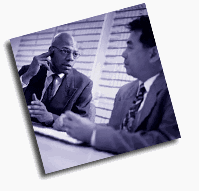
The Report of Findings
| Продажи | ||||
| Sales.com | ||||
| Providing... | ||||
by Graham Denton
What happens when your company receives a request for proposal? In many companies, what follows is a frenzied attempt to psych out the customer's real purchasing requirements (that is, to read between the lines of the official description), to design a single dynamite solution that meets all the specs, to accompany that solution with a ton of documentation, to attach the lowest ticket price that won't send you to the poorhouse, and then to send it off, beribboned and bowed, and hope for the best. There's an incredible amount of guesswork that goes into most proposals. Is it any wonder that their hit ratio is so low?
 Consultants
Tony Alessandra and Rick Barrera think they have a better way. In Collaborative
Selling, they recommend that when you receive an RFP, your first step
should be to sit down with the prospective client and go over in detail
what his company really needs. That's a way of providing assistance at
the spec-writing stage-that is, of being a part of the solution design-rather
than responding to specs that were written by someone else (for example,
one of your competitors). Then, once you've clearly determined what the
customer is looking for, you should submit a document called "Report of
Findings." Not a hard-and-fast proposal that says "Take it or leave
it," but a menu of possible options that your customer can consider, and
on which you're willing to help him arrive at decisions.
Consultants
Tony Alessandra and Rick Barrera think they have a better way. In Collaborative
Selling, they recommend that when you receive an RFP, your first step
should be to sit down with the prospective client and go over in detail
what his company really needs. That's a way of providing assistance at
the spec-writing stage-that is, of being a part of the solution design-rather
than responding to specs that were written by someone else (for example,
one of your competitors). Then, once you've clearly determined what the
customer is looking for, you should submit a document called "Report of
Findings." Not a hard-and-fast proposal that says "Take it or leave
it," but a menu of possible options that your customer can consider, and
on which you're willing to help him arrive at decisions.
Defining multiple options is important because, when you submit a proposal, no matter what they say, your customers will tend to view it as "the only solution you could come up with." You're bound to miss some details, which could sink your chances. A Report of Findings invites discussion of just such details: It's an invitation to discussion, not your company's final offer. "Salespeople write proposals, but consultants write reports."
But providing multiple options doesn't mean delivering a twenty-page laundry list of all the things that your company is capable of doing. Each option you describe as a potential part of a final package should:
This last item is not optional. Alessandra and Barrera are clear on this point: Always anticipate limits rather than having them descend upon you. They cite a report by the Boston-based Forum Corporation which found that it is reliability, much more than responsiveness, that clients value in vendors.
In addition to a "menu" of options that are open to discussion, a Report of Findings should also include your recommendation for possible courses of action and a one-page cover sheet or executive summary that includes a statement of the desired outcome, as you understand it, a review of the decision or success criteria, and a bullet-point overview of the menu options. You should bring this package to the customer, rather than mailing it, so you can sit down once again and explore solutions. A focused Report of Findings can be an invaluable tool in helping you and the customer to do that collaboratively.